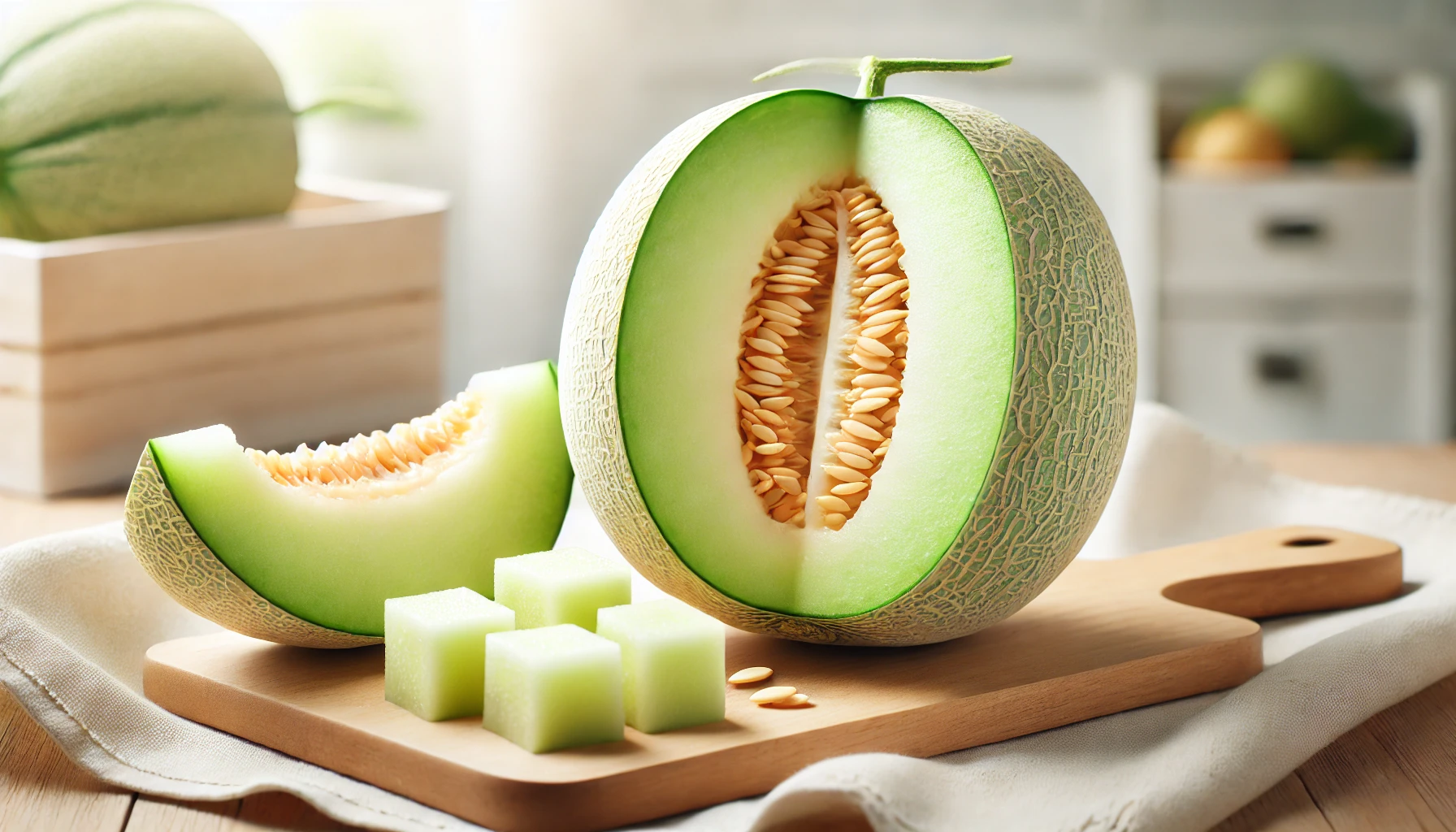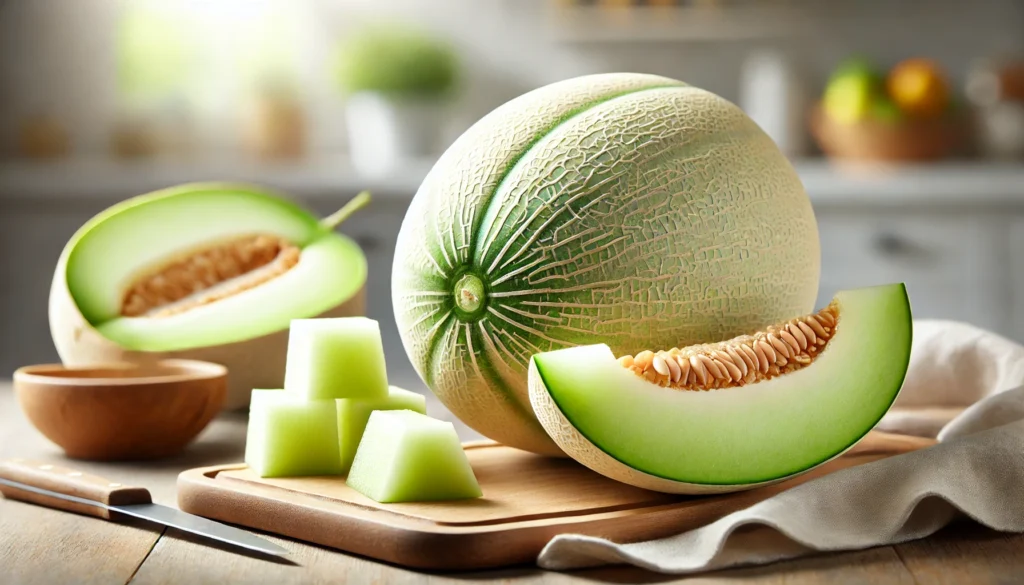Sweet and Refreshing: The Ultimate Guide to Honeydew Melonjjj

Introduction
Honeydew melon, often referred to as the “queen of melons,” is a deliciously sweet and refreshing fruit that has gained popularity worldwide. Known for its pale green flesh and smooth rind, honeydew is a staple in fruit salads, smoothies, and various dishes. Its mild sweetness and high water content make it an ideal summer treat, offering both hydration and a satisfying taste.
In addition to being delicious, honeydew melon is packed with essential nutrients that support overall health. This fruit is an excellent source of vitamins, minerals, and antioxidants, making it a healthy addition to any diet. Whether you enjoy it fresh, blended, or paired with other ingredients, honeydew melon is a versatile fruit worth exploring.
This article provides a comprehensive look at honeydew melon, covering its origins, nutritional benefits, selection tips, and creative ways to enjoy it. By the end, you will have a thorough understanding of why this fruit deserves a spot in your kitchen.
The Origins and History of Honeydew Melon
The history of honeydew melon traces back to ancient civilizations, with its roots deeply embedded in the Mediterranean and Middle Eastern regions. Some of the earliest records of melons date back to ancient Egypt, where they were revered for their refreshing taste and hydrating properties. Over time, honeydew spread to Persia, where it became a staple in royal gardens and elite dining tables.
By the 15th century, honeydew melon had made its way to Europe, where it was cultivated extensively in France and Spain. The fruit’s smooth texture, subtle sweetness, and adaptability to warm climates made it a favorite among farmers and consumers alike. European explorers later introduced honeydew to the Americas, where it thrived in regions with warm, dry climates, such as California and Arizona.
Today, honeydew melon is grown in many parts of the world, with China, the United States, and Turkey being among the largest producers. Modern farming techniques have improved the fruit’s quality, making it widely available year-round. Despite its evolution, honeydew melon remains a symbol of refreshment and vitality, cherished for its unique taste and nutritional benefits.
Nutritional Benefits and Health Advantages
Honeydew melon is not only delicious but also packed with essential nutrients that contribute to overall well-being. One of its primary benefits is its high water content, which makes it an excellent hydrating fruit, especially during hot summer months. With nearly 90% water, honeydew helps keep the body hydrated and supports proper digestion.
Rich in vitamins and minerals, honeydew melon is a powerhouse of nutrients. It is an excellent source of vitamin C, which boosts the immune system and promotes healthy skin. Additionally, honeydew contains potassium, a crucial mineral that supports heart health by regulating blood pressure and reducing the risk of stroke.

The fruit also contains dietary fiber, which aids digestion and promotes gut health. The natural antioxidants found in honeydew melon help fight inflammation and protect cells from oxidative stress. Compared to other melons, such as cantaloupe and watermelon, honeydew provides a balanced mix of nutrients, making it a valuable addition to any diet. Whether eaten fresh or blended into smoothies, honeydew melon offers a guilt-free way to satisfy sweet cravings while nourishing the body.
How to Select, Store, and Prepare Honeydew Melon
Selecting a ripe honeydew melon can be tricky, but a few key indicators can help you choose the best one. A ripe honeydew melon should have a creamy yellow rind and a slightly waxy texture. When gently pressed at the stem end, it should yield slightly without being too soft. Additionally, a sweet fragrance is a good sign that the melon is ready to eat.

Proper storage is essential to maintain the freshness and flavor of honeydew melon. If unripe, store the melon at room temperature until it softens. Once ripe, it should be kept in the refrigerator and consumed within a few days. For longer storage, cut honeydew melon into slices or cubes and place them in an airtight container in the fridge.
Preparing honeydew melon is simple. Start by cutting the melon in half and scooping out the seeds. Then, slice the melon into wedges or cubes based on your preference. It can be eaten fresh, added to fruit salads, or blended into smoothies. Honeydew’s versatility makes it an easy and delicious ingredient to incorporate into various dishes.
Delicious Ways to Enjoy Honeydew Melon
Honeydew melon can be enjoyed in numerous ways, whether eaten fresh, blended, or used in creative recipes. One of the most popular ways to consume honeydew is by slicing it and eating it on its own. Its naturally sweet and juicy flesh makes it a refreshing snack for any time of the day.
Another great way to enjoy honeydew is by incorporating it into fruit salads. Pair it with berries, oranges, and grapes for a vibrant mix of flavors. Honeydew melon is also an excellent addition to smoothies. Blend it with yogurt, mint, and a splash of lime for a refreshing and healthy drink.

For those who enjoy experimenting, honeydew melon can be used in savory dishes as well. Add diced honeydew to salads with feta cheese and arugula for a sweet and tangy combination. It also works well in salsas, where its mild sweetness balances out the heat from jalapeños and lime juice. Whether sweet or savory, honeydew melon adds a delightful twist to various dishes.
Conclusion
Honeydew melon is a versatile and nutritious fruit that offers numerous health benefits and culinary possibilities. Its sweet, refreshing taste, combined with its hydrating properties, makes it an excellent choice for hot summer days. Packed with vitamins, minerals, and antioxidants, honeydew melon is a great addition to a balanced diet.
From selecting the perfect melon to exploring creative recipes, this fruit provides endless opportunities to enjoy its unique flavor. Whether you prefer it fresh, blended, or incorporated into savory dishes, honeydew melon remains a timeless favorite among fruit lovers. By adding it to your daily diet, you can enjoy both its delicious taste and its many health benefits.
Frequently Asked Questions (FAQs)
How can I tell if a honeydew melon is ripe?
Look for a creamy yellow rind, a slightly waxy texture, and a sweet aroma.
What is the best way to store a honeydew melon?
Store unripe melons at room temperature; refrigerate ripe melons and consume within a few days.
Can I freeze honeydew melon for later use?
Yes, cut into cubes and store in an airtight container for smoothies or frozen snacks.
Is honeydew melon good for weight loss?
Yes, its low calorie and high water content make it a great weight-loss food.
Does honeydew melon have any medicinal benefits?
It supports hydration, digestion, and immune health due to its vitamins and antioxidants.
How does honeydew compare to cantaloupe in taste and nutrition?
Honeydew is milder and sweeter, while cantaloupe has more beta-carotene.
Can honeydew melon be used in skincare?
Yes, its vitamin C and hydration properties benefit the skin.
Are there different honeydew melon varieties?
Yes, including orange-fleshed and hybrid varieties.
Is honeydew melon safe for pets?
Yes, in small amounts, but avoid giving them the seeds.
What are some creative ways to use leftover honeydew melon?
Try making sorbets, juices, or fruit salsas for a refreshing twist.


